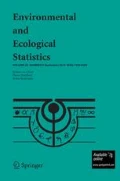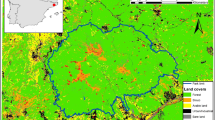Abstract
The environmental decision-maker is aware of the increasing difficulties in finding sufficient financial resources for nature conservation. So he must focus his attention on ecological situations that more than the others merit considering and defending because of elevated value but also because of risk for their intrinsic characteristics and for human pressure acting on them. Usually an ecological scientist focuses his attention on the natural patches of the landscape, analyzing their peculiar ecological traits forgetting that, even if we want to protect some environmental critical situations, this can be done only moving to the administrative partition of the territory since the central and local environmental stakeholders have primary interest in providing funds to those involved in those critical situations. The present work shows a methodological approach, consisting of a set of statistical and geoinformational tools, considering both ecological and socio-demographical indicators. The goal is not simply to give some general guidelines for environmental policies to the involved stakeholders but focuses more on finding out which administrative local partitions in a study area are more worthy to receive urgently the priority funds for biodiversity protection to face critical environmental situations often due to a combination of intrinsic ecological parameters and external human pressure ones. Obtaining results that cover 5% of the Communes involved in the area seems to be a realistic result that a decision-maker can support and fund. Methodologically and geospatial data analytically, the investigation offers interesting challenges for surveillance geoinformatics of hotspot detection and prioritization, because of the presence of multiple hotspots and multiple sets of multiple indicators.
Similar content being viewed by others
References
Brüggemann R, Patil GP (2010) Ranking and prioritization for multi-indicator systems: introduction to partial order applications. Monograph, Springer, pp 400 (in Press)
Ferrarini A (2005) Analisi e valutazioni spazio-temporali mediante GIS e Telerilevamento del grado di Pressione antropica attuale e potenziale gravante sul mosaico di habitat di alcune aree italiane. Ipotesi di pianificazione. PhD Thesis, Università di Parma, Parma, Italy
Kim K, Pauleit S (2007) Landscape character, biodiversity and land use planning: the case of Kwangju City Region, South Korea. Land Use Policy 24: 264–274
Margules C, Usher MB (1981) Criteria used in assessing wildlife conservation potential: a review. Biol Conserv 21: 79–109
Miller JR, Hobbs RJ (2002) Conservation where people live and work. Conserv Biol 16: 330–337
Mohan J (1993) An autoecological site design model for nature reserves. Master’s Thesis, School of the Environment, Duke University, Durham, NC
Myers WL, McKenney-Easterling M, Hychka K, Griscom B, Bishop JA, Bayard A, Rocco GL, Brooks RP, Constantz G, Patil GP, Taillie C (2006) Contextual clustering for configuring collaborative conservation of watersheds in the Mid-Atlantic Highlands. Environ Ecol Stat 13: 391–407
Nilsson CN, Grelsson G (1995) The fragility of ecosystems: a review. J Appl Ecol 32: 667–692
Patil GP, Taillie C (2004) Multiple indicators, partially ordered sets, and linear extensions: multi-criterion ranking and prioritization. Environ Ecol Stat 11: 199–228
Patil GP, Taillie C (2004) Upper Level Set scan for detecting arbitrarily shaped hotspots. Environ Ecol Stat 11: 183–197
Patil GP, Joshi SW, Myers WL, Koli RE (2009) ULS scan statistic for hotspot detection with continuous gamma reponse. In: Glaz J, Pozdnyakov V, Wallenstein SScan statistic: methods and applications. Birkhäuser, Boston
Patil GP, Joshi SW, Koli RE (2009b) Digital governance and hotspot geoinformatics with continuous fractional response. In: Indian statistical institute platinum jubilee volume on statistics. Kolkata, India (in press)
Pierce SM, Cowling RM, Knight AT, Lombard AT, Rouget M, Wolf T (2005) Systematic conservation planning products for land-use planning: interpretation for implementation. Biol Conserv 125(4): 441–458
Poiani KA, Baumgartner JV, Buttrick SC, Green SL, Hopkins E, Ivey GD, Seaton KP, Sutter RD (1998) A scale-independent, site conservation planning framework in The Nature Conservancy. Landsc Urban Plan 43(1–3): 143–156
Ratcliffe DA (1977) A nature conservation review I. Cambridge University Press, UK
Rookwood P (1995) Landscape planning for biodiversity. Landsc Urban Plan 31: 379–385
Rossi O, Zurlini G (1998) Biodiversità e Carta della Natura. In: Atti dei Convegni Lincei Conservazione e Valorizzazione della biodiversità. Accad Naz Lincei Rome Italy 145:91–112
Rossi O (2001) Introduzione. In: Rossi O (ed) Cartografia multiscalare della Natura. Supergrafica, Parma, pp 11–20
Rossi P, Pecci A, Amadio V, Rossi O, Soliani L (2008) Coupling indicators of ecological value and ecological sensitivity with indicators of demographic pressure in the demarcation of new areas to be protected: the case of the Oltrepò Pavese and the Ligurian-Emilian Apennine area (Italy). Landsc Urban Plan 85: 12–26
Rossi P (2005) Stima e Valutazione del grado di Sensibilità, Fragilità e Valore ecologico del mosaico ambientale di alcune aree italiane mediante dati a terra ed immagini telerilevate. PhD Thesis, Università di Parma, Parma, Italy
Smith PGR, Theberge JB (1986) A review of criteria for evaluating natural areas. Environ Manage 10(6): 715–734
Tomaselli M (2004) Gli habitat CORINE Biotopes dell’Oltrepò Pavese e Appennino Ligure Emiliano. Rapporto Tecnico, Ministero dell’Ambiente, Italy
Waldhardt R (2003) Biodiversity and landscape—summary, conclusions and perspectives. Agric Ecosyst Environ 98(1–3): 305–309
Wyant JG, Meganck RA, Ham SH (1995) A planning and decision-making framework for ecological restoration. Environ Manage 19: 789–796
Zurlini G, Amadio V, Rossi O (1999) A landscape approach to biodiversity and biological health planning: The Map of Italian Nature. Ecosyst health 5(4): 294–311
Author information
Authors and Affiliations
Corresponding author
Additional information
This material is based upon work supported by (i) the United States National Science Foundation under Grant No. 0307010, (ii) The Map of Italian Nature Project of the Ministry of Environment, Italy, and (iii) The Agency for Environmental Protection and Technical Services of Italy (ex-APAT now in ISPRA). Any opinions, findings, and conclusions or recommendations expressed in this material are those of the author(s) and do not necessarily reflect the views of the agencies.
Rights and permissions
About this article
Cite this article
Pecci, A., Patil, G., Rossi, O. et al. Biodiversity protection funding preference: a case study of hotspot geoinformatics and digital governance for the Map of Italian Nature in the presence of multiple indicators of ecological value, ecological sensitivity and anthropic pressure for the Oltrepò Pavese and Ligurian-Emilian Apennine study area in Italy. Environ Ecol Stat 17, 473–502 (2010). https://doi.org/10.1007/s10651-010-0163-7
Received:
Revised:
Published:
Issue Date:
DOI: https://doi.org/10.1007/s10651-010-0163-7
Keywords
- Map of Italian Nature
- Biodiversity protection funding preference
- Hotspot geoinformatics
- Digital governance
- Hotspot detection
- Multicriteria prioritization
- Multiple indicators
- Ecological value
- Ecological sensitivity
- Anthropic pressure
- Oltrepò Pavese and Ligurian-Emilian Apennine study area
- Ideal vector method
- Multiple hotspots
- Ecological attention
- Ecological fragility




